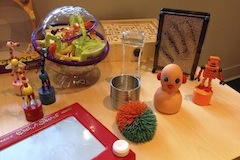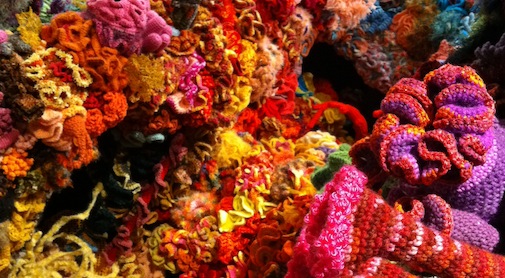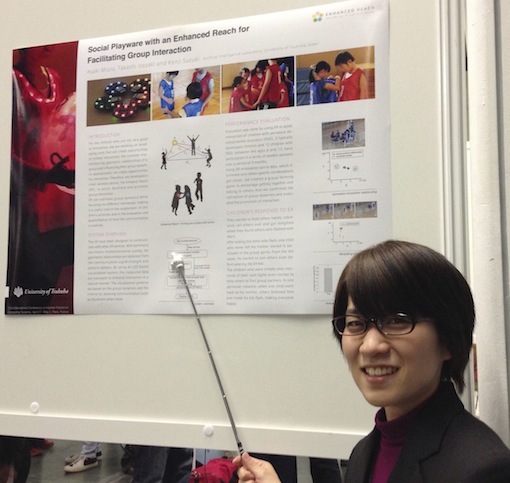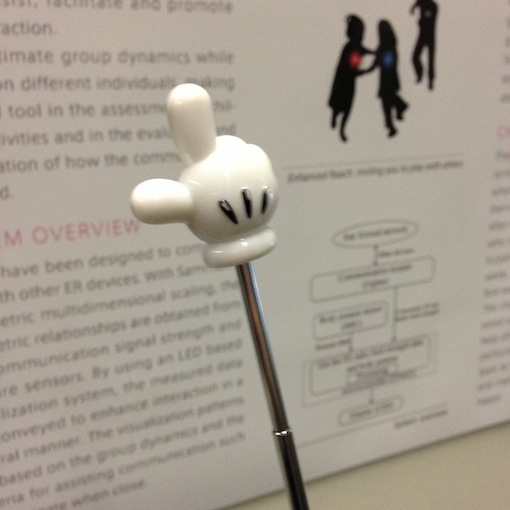[Cross posted at my personal site]
A Marginally Good Idea
 Things to play with in our lab. For thinking.Ever have an idea come to you all in a flash? I had one of those thoughts two years ago, and it’s slowly grown from a handful of interesting observations and questions into an ongoing research project. A really cool research project: Fidget Widgets.
Things to play with in our lab. For thinking.Ever have an idea come to you all in a flash? I had one of those thoughts two years ago, and it’s slowly grown from a handful of interesting observations and questions into an ongoing research project. A really cool research project: Fidget Widgets.
Let’s back up. Watching a student in one of my classes bounce the arrow keys on her laptop keyboard led me to think about “software with margins.” And this led to investigating doodling, fiddling, and fidgeting behaviors. Fast forward and Fidget Widgets were born.
So What’s a Fidget Widget?
A Fidget Widget is [see video below]:
- Tangential. One “mindlessly” engages a Fidget Widget while mulling an idea or paused in work.
- Playful. The goal is the experience of the interaction not achieving a goal with the interaction itself.
- Digital. To allow for more supple experiences than possible in physical objects (e.g. infinite resources, large virtual worlds in small spaces, etc.) Fidget Widgets are programmable. Interactions are reactive, though not necessarily predictably so.
- Tangible. Engaging the bodily movement of fidgeting and doodling inherent in our physical inspirations, Fidget Widgets embody physicality beyond only screen-based abstractions.
Ultimately, our goal is to allow our users to select an interaction to play with in order to temporarily but measurably improve creativity, focus, or calm while working. We have much more work ahead of us to get there.
What We’ve Published + Latest News
My advisor and I published a Work in Progress Fidget Widgets: Secondary Playful Interactions in Support of Primary Serious Tasks at CHI 2013 in Paris. If you’re interested in a brief overview of all the fascinating background work, this paper has you covered.
We just recently learned that our full paper Designing for the Physical Margins of Digital Workspaces: Fidget Widgets in Support of Productivity and Creativity was accepted for publication at TEI 2014 in Munich. This is my first full paper publication as a graduate student (I could get used to this globetrotting).
In other news, I now have the good fortune to be working on Fidget Widgets with Kacie Kinzer of tweenbots fame. We have good things in the works (more below).
Video!
Early prototypes of the Fidget Widget concept. These aren’t games; these are playful interactions. See one of our papers to learn more.
What We’ve Learned So Far
We’ve learned so much. Doodling, fiddling, and fidgeting behaviors are widespread and not much research has been done of them. There’s a strong link between brain mechanisms and the hand. Mind, affective state, and bodily motions are all interrelated. People have strong opinions about the items on their desk they reach for while working. In fact, despite being fun and engaging, the prototype interactions in the video below have generated considerable feedback about the form factor and materials. Nearly universal in what we’ve heard is a desire for highly tactile, satisfying, and pliable objects. Rigid boxes of electronics are not the way to move ahead.
What’s Next
The two most immediate challenges are both design related: research study design and product design.
Conducting experiments with users are easiest when they have a direct experience with a manipulable intervention. Here our Fidget Widgets complicate much of traditional research design because they are intentionally tangential, mindless, and goal-less. At present we’re looking into some of the innovative research done in developing the concept of Flow that shared some of these same research challenges.
What we’ve heard from users is that they want highly tactile experiences. The feeling in the hand requires much stimulation and variation. This will require lots of work with materials and sensors and unconventional electronics design. First, however, we’re stepping back and launching into design research to look at what sorts of objects our user population is already interacting with at their desks.
My advisor recently connected me to Kacie Kinzer. She and I are cooking up something online that we hope will attract some good attention and collect a rich picture of the items and materials and behaviors people employ when they fiddle with things at their desks. When we launch that, I’ll write more about it all.
 Tuesday, December 3, 2013 at 11:47AM
Tuesday, December 3, 2013 at 11:47AM 




